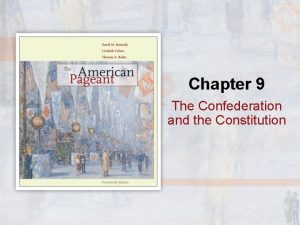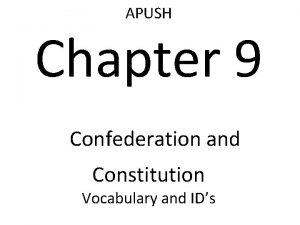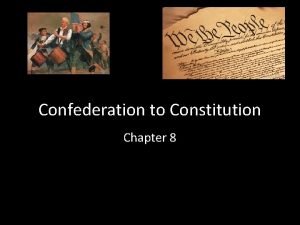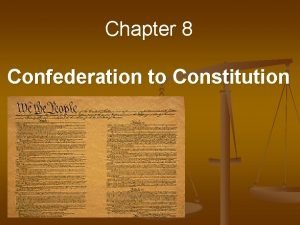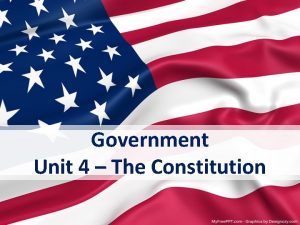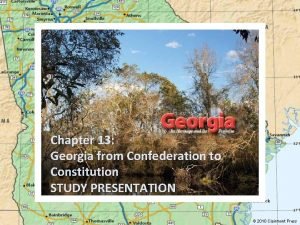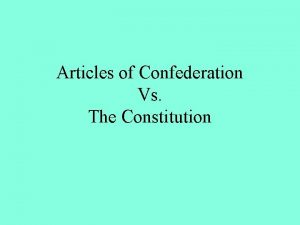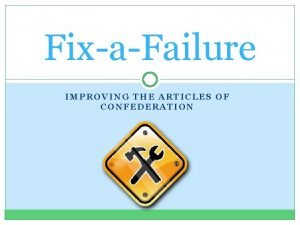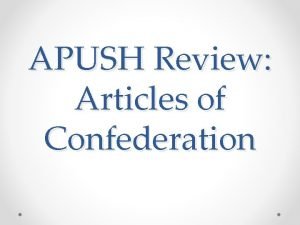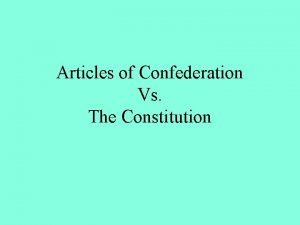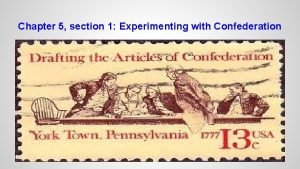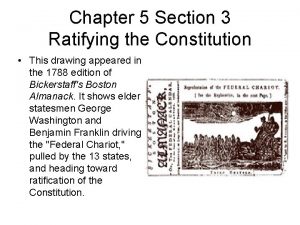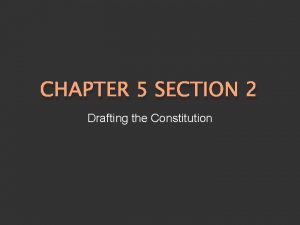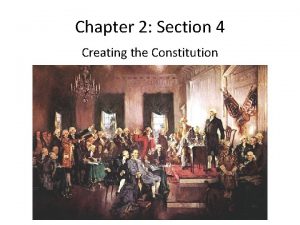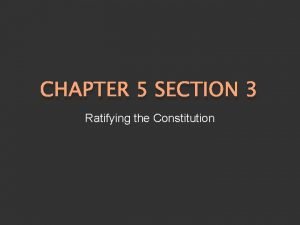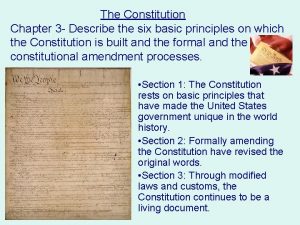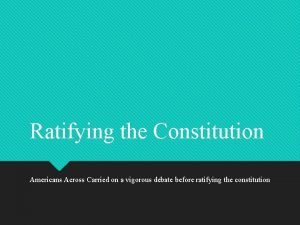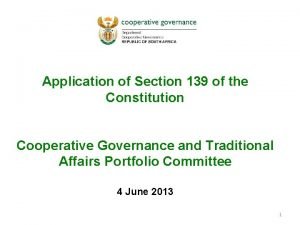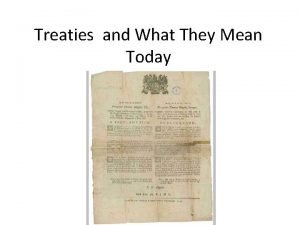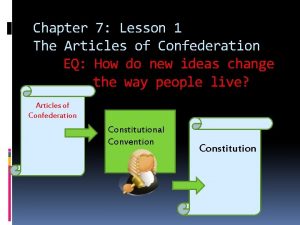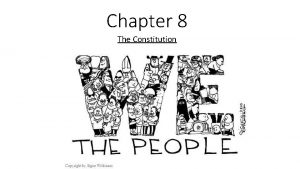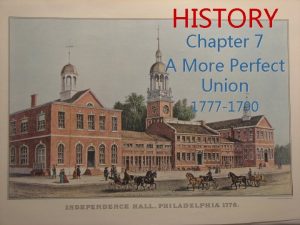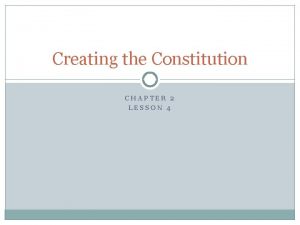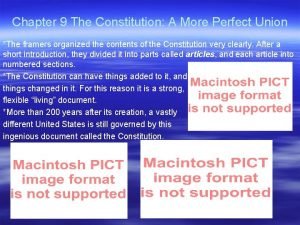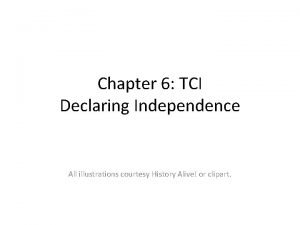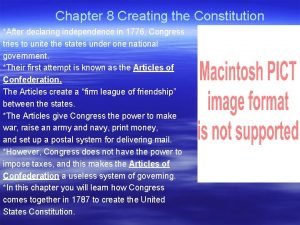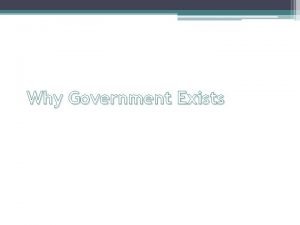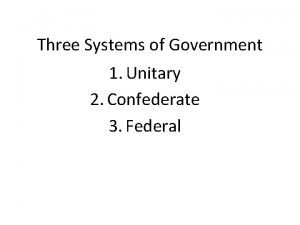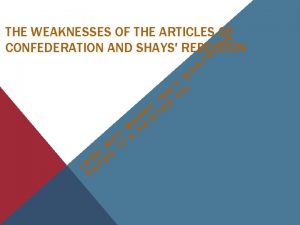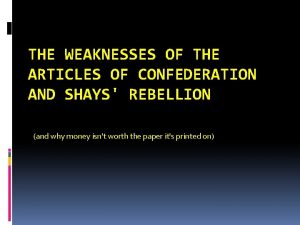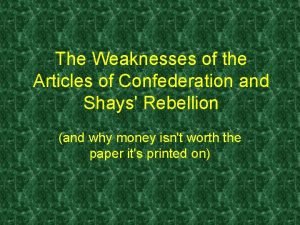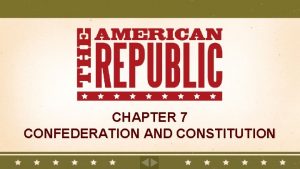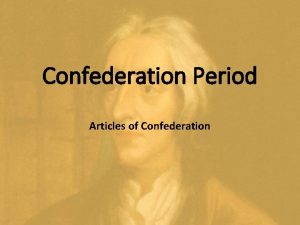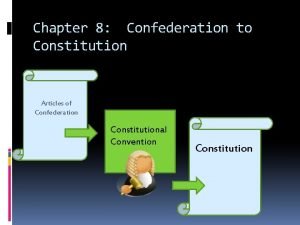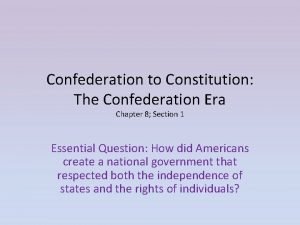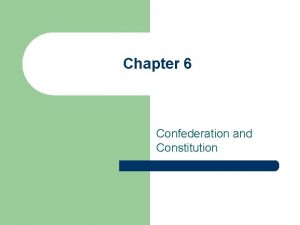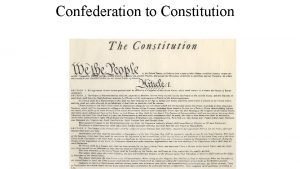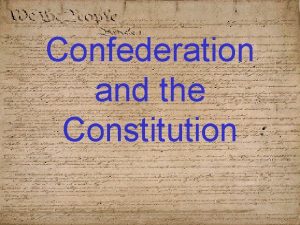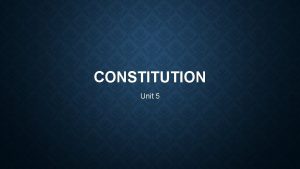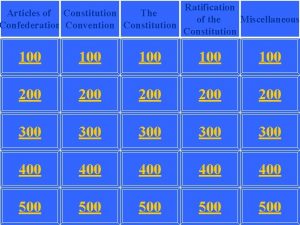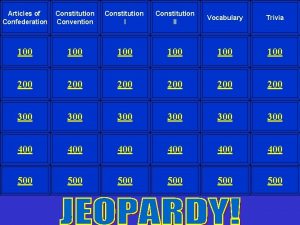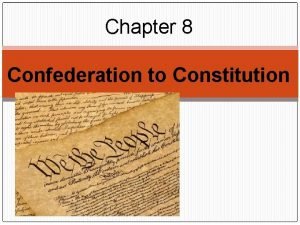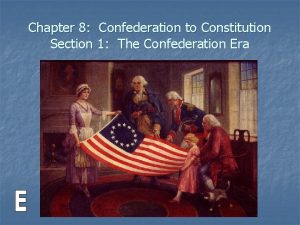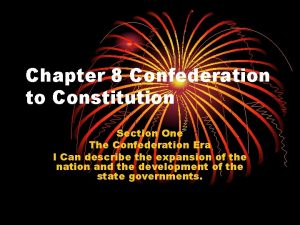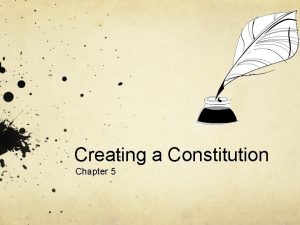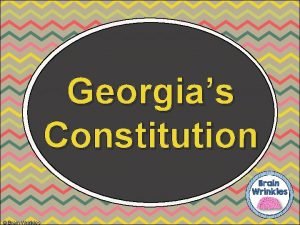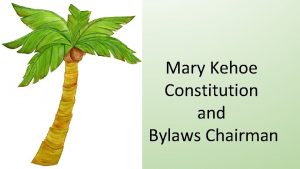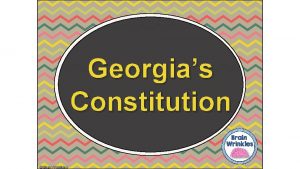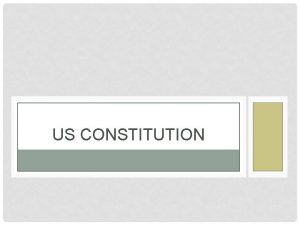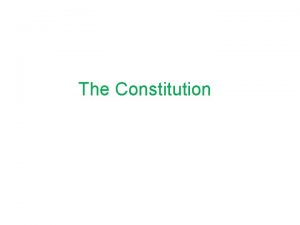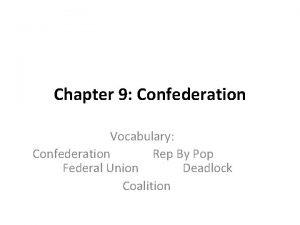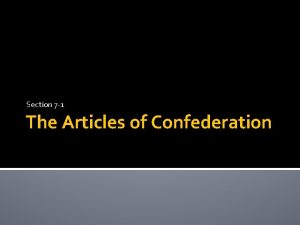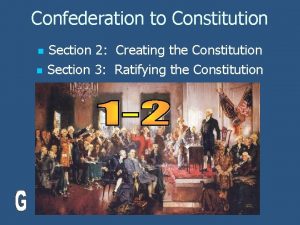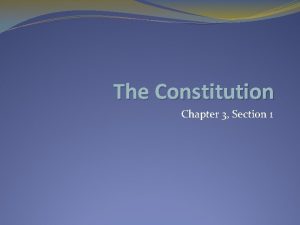Chapter 8 Confederation to Constitution Ch 8 Section





































- Slides: 37

Chapter 8 Confederation to Constitution

Ch 8 Section 1

Moving West n Daniel Boone & many others cut a path through the Appalachian Mountains to get to Kentucky n n They called this path Wilderness Road – it opened Kentucky to settlement The road was not easy to travel – It was narrow for carts & wagons Some western lands were inhabited by Native Americans but this did not stop settlers from going West By the early 1790 s, about 100, 000 Americans lived west of the Appalachian Mountains.

New State Governments n Once the states had independence, they set out to create their own state governments. n n The states did not want to destroy the political systems they had in the colonies. All states had formed a republican form of government. n In a republic, the PEOPLE choose representatives to govern them

The Articles of Confederation n n While the states set up their government, Americans discussed having a national government. n In 1776, the Continental Congress began to develop a plan for national government. WHY? The final plan they arrived at was called the Articles of Confederation. n This was the FIRST national Constitution in the Americas.

The Articles of Confederation n The STATES have MOST of the power The National Government has LITTLE power

The Articles of Confederation n The Articles gave the national government only a few powers n state governments important powers n National government State governments n. Wage war n. Set taxes n. Make peace n. Enforce national laws n. Sign treaties n. States controlled lands west of the Appalachian n. Issue money Mountains n. NO President – states had a vote

Moving West n This was America in 1787 n n n With all the new land, people wanted move West When we won the Revolutionary war, we gained the lands in orange Soon people began to move there. to

What To Do With the Western Land Claims? n Smaller states needed this issue to be settled before they would agree to the Articles of Confederation ?

The Articles of Confederation Pictured here is the FIRST Constitution in America… the 1 st official government

What to do with the land? n n Congress passed laws on how to divide & govern these lands. (Northwest Territory) ? Land Ordinance of 1785 – surveyors would take out six-square-mile plots, called territories n These lands later became known as the Northwest Territory

The Land Ordinance of 1785

What to do with the land? n Northwest Ordinance – described how the Northwest territories would be governed. (how ? states could be formed) n n Formed states such as Ohio, Indiana, Michigan, Illinois & Wisconsin If there were 60, 000 free males in a territory, they could apply for statehood Slavery was outlawed Freedom of religion & trial by jury were guaranteed

Weaknesses of the Articles n NATIONAL GOVERNMENT WAS TOO WEAK! 1. 2. n n National government has few powers Could not levy taxes to pay soldiers from Revolutionary War The country was in debt! People in the nation began to face hard times

Shay’s Rebellion n People in Massachusetts had little money, like many others in the states Farmers from Massachusetts demanded money from the state Legislature n The state refused n The farmers, led by Daniel Shays, rebelled n The farmers marched on a federal building ready to attack. n

Weaknesses of the Articles of Confederation n Lacked power to enforce laws n Lacked power to levy taxes n Lacked power to regulate and promote trade n Required all 13 states to approve changes in the Articles

Shay’s Rebellion n America’s leaders realized that the farmers’ uprising was trouble for the government. n n Feared rebellion may spread Shay’s Rebellion proved the Articles of Confederation WOULD NOT WORK! It led to the Constitutional Convention.

These Problems Led Up to the Constitutional Convention n The need to promote trade among the states n Shay’s Rebellion n The rising number of debtors n NOT the Land Ordinance of 1785

Ch 8 Section 2

Writing a Constitution n Leaders realized the Articles of Confederation would need to be changed. 55 delegates were called to the Constitutional Convention in Philadelphia, Pennsylvania. n The 1 st plan was to re-write the Articles. n The result was writing a whole new Constitution. n Some delegates included James Madison, George Washington & Ben Franklin. n n Thomas Jefferson & Patrick Henry were not there.

The Convention’s Delegates n The convention did not reflect the diverse U. S. population of the 1780’s n There were NO Native Americans, African Americans, or women among the delegates

The Constitutional Convention

Writing a Constitution - Plans n The work for a new plan of a National government began n Virginia Plan – Government would have 3 branches: executive, legislative & judiciary 2 houses – both have representatives based on population – these reps would make decisions in government. Small states did NOT like it! Large states LIKED this!

Three Branches of Government Legislative: includes Congress Executive: includes President & Vice President Judicial: includes Courts

New Jersey Plan n Small states had a response to the Virginia Plan – they proposed an alternative plan. n New Jersey Plan – 1 house – each state would have only 1 representative (1 vote) The Great Compromise – 3 branches of government: executive, legislative, judicial 2 houses – n House of Representatives – representatives based on population n Senate – 2 representatives for each state

The Great Compromise 3 Branches of Government 2 Houses - Senate & House of Representatives number of representatives based on population Good for big states Senate 2 representatives per state no matter the population Good for small states

Three-Fifths Compromise n Three-Fifths Compromise - Three-Fifths (3/5) of the slave population would be counted as part of the population when determining representatives for the House and would be used for setting direct taxes on states. n 3 out of every 5 slaves would count For example: n On Mr. Smith’s Plantation, 6 slaves would count towards the population count in Texas n

Ch 8 Section 3

Debate over Constitution n The Constitution caused disagreements between Americans. The writers suspected people might be afraid of the power of the National government. n n Constitution was based on federalism Federalism – system of government in which power is shared between the national government and the states.

Federalism

Supporters of Constitution People who supported the Constitution were called Federalists n People who opposed (didn’t support) the Constitution and would OPPOSE ratification were called Anti-federalists n n Thought the national government had too much power. (remember the King of England? )

The Federalist Papers Federalists wrote essays to answer the Anti-federalists’ attacks on the Constitution. n Federalists published The Federalist papers n n Written by Alexander Hamilton, John Jay & James Madison

The Federalist Papers n Alexander Hamilton, author of The Federalist papers

Federalists vs. Antifederalists Both Different branches of government Supported a bill

The Bill of Rights The Constitution had to be amended changed n People wanted their rights spelled out for them in the Constitution n Bill of Rights – the first 10 amendments (changes) to the Constitution

The Bill of Rights n Many states wouldn’t sign the Constitution without a bill of rights. n The writers of the Constitution wanted to protect people’s personal rights and freedoms. n Many people believed it was needed to limit the power of the national government.

Visual Summary 1777 Continental Congress passes the Articles of Confederation. 1786 Annapolis Convention is held. 1786– 1787 Shay’s Rebellion occurs. 1789 Government created by the new Constitution takes power. 1777– 1781 States debate ratification of the Articles of Confederation. 1781 Articles of Confederation go into effect. 1787 Constitutional Convention is held in Philadelphia. 1788 U. S. Constitution is ratified. 1791 Bill of Rights is added to the Constitution. The Constitution has lasted for over 200 years!
 Chapter 9 the confederation and the constitution
Chapter 9 the confederation and the constitution Chapter 9 confederation and constitution
Chapter 9 confederation and constitution Chapter 8 confederation to constitution
Chapter 8 confederation to constitution Chapter 8 confederation to constitution
Chapter 8 confederation to constitution Articles of confederation vs constitution
Articles of confederation vs constitution Articles of confederation vs constitution
Articles of confederation vs constitution Constitution vs articles of confederation
Constitution vs articles of confederation Failures of the articles of confederation
Failures of the articles of confederation Articles of confederation vs constitution apush
Articles of confederation vs constitution apush Articles of confederation vs constitution chart
Articles of confederation vs constitution chart Texas constitution vs u.s. constitution venn diagram
Texas constitution vs u.s. constitution venn diagram Nc constitution vs us constitution
Nc constitution vs us constitution Constitution what is constitution
Constitution what is constitution The constitution lesson 1 principles of the constitution
The constitution lesson 1 principles of the constitution Experimenting with confederation
Experimenting with confederation Chapter 5 section 3 ratifying the constitution
Chapter 5 section 3 ratifying the constitution Chapter 5 section 2 drafting the constitution
Chapter 5 section 2 drafting the constitution Section 4 creating the constitution
Section 4 creating the constitution Chapter 5 section 3 ratifying the constitution
Chapter 5 section 3 ratifying the constitution Chapter 3 section 1 constitution scavenger hunt answers
Chapter 3 section 1 constitution scavenger hunt answers Chapter 5 section 3 ratifying the constitution answer key
Chapter 5 section 3 ratifying the constitution answer key Section 139(7) of the constitution
Section 139(7) of the constitution Canadian constitution section 35
Canadian constitution section 35 Chapter 7 lesson 1 the articles of confederation answer key
Chapter 7 lesson 1 the articles of confederation answer key Section quick check chapter 10 section 1 meiosis answer key
Section quick check chapter 10 section 1 meiosis answer key Lesson 1 structure and principles of the constitution
Lesson 1 structure and principles of the constitution Chapter 7 lesson 2 forging a new constitution
Chapter 7 lesson 2 forging a new constitution Lesson 4 creating the constitution answer key
Lesson 4 creating the constitution answer key Chapter 9 the constitution a more perfect union
Chapter 9 the constitution a more perfect union Tci declaration of independence
Tci declaration of independence Chapter 8 creating the constitution
Chapter 8 creating the constitution Confederation system of government
Confederation system of government Political weaknesses of the articles of confederation
Political weaknesses of the articles of confederation Examples of confederations
Examples of confederations Confederation system of government
Confederation system of government Achievements of the articles of confederation
Achievements of the articles of confederation Problems with articles of confederation
Problems with articles of confederation Articles of confederation strengths
Articles of confederation strengths
